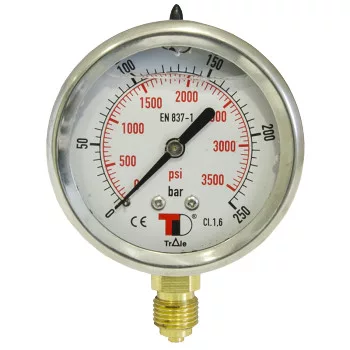
The Function and Role of Pressure Gauges in Hydraulic Systems
The Function and Role of Pressure Gauges in Hydraulic Systems
The efficiency and safety of hydraulic systems largely depend on the accurate monitoring and regulation of pressure. Pressure gauges play a key role in this process, as they allow for the continuous observation of system operating conditions.
These devices help prevent malfunctions, optimize performance, and ensure safety whether in industrial, agricultural, or residential applications.
At MPH, we offer a diverse and high-quality selection of pressure gauges, so it's easy to find the ideal model for a wide range of applications. It’s important to choose a pressure gauge compatible with the system’s operating conditions, as only then can it effectively fulfill its purpose. Our expert colleagues are available to assist in the selection process and provide valuable tips and technical guidance.
How a Pressure Gauge Works – In Brief
The operation of a pressure gauge is based on a simple mechanical principle, which allows it to perform reliably and effectively.
The internal mechanism of a pressure gauge converts the fluid or gas pressure within the system into mechanical movement. The most common type is the Bourdon tube gauge, which uses a curved tube to measure pressure. The tube deforms in response to pressure changes, and this motion is transmitted to a needle on the dial.
More advanced models come equipped with electronic sensors, allowing for greater measurement accuracy and easier data reading. These are especially useful in applications where high precision is required. Pressure gauges are available in different accuracy classes, so it’s important to select the appropriate model based on the intended use.
Back and Bottom Connection Pressure Gauges
The connection position of a pressure gauge fundamentally determines how and where it can be installed.
Back connection gauges, such as the DN100 0-100 pressure gauge, allow for panel or wall mounting. This type is ideal in situations where the front of the gauge must be easily visible, such as on control panels. Their compact design also offers a space-saving solution. Bottom connection gauges are typically installed in a standing, vertical position. These are often used on machines or equipment where the gauge must face upward or be positioned vertically for optimal visibility and function.
Maintenance to Preserve Accuracy
Regular maintenance is essential for pressure gauges to maintain measurement precision throughout operation.
Calibration must be performed at scheduled intervals to ensure accurate readings. Faulty measurements can cause serious damage to the entire hydraulic system.
Because a pressure gauge is a sensitive instrument, it should always be protected from physical impacts, shocks, and vibrations, all of which can negatively affect its accuracy.
Maintenance should also include regular cleaning. During this process, check for blockages or contaminants that could prevent the device from operating correctly and precisely.
Pressure gauges are therefore critical and delicate components of hydraulic systems that require proper care in order to ensure precise pressure readings.
If you have any further questions about the devices we offer, feel free to contact us through any of our available channels.

